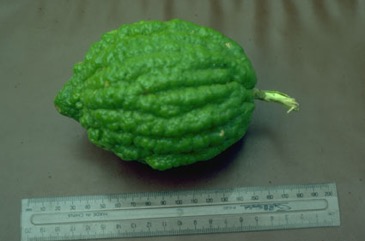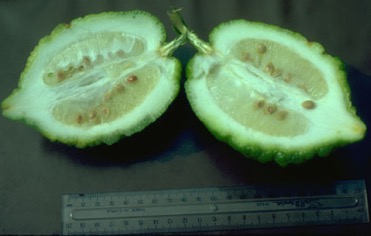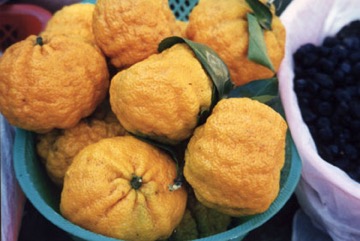Citron

A subtropical plant. It prefers rich, moist soils. The soils need to be well aerated and not waterlogged. They should be in a protected sunny position. They are drought and frost tender. It needs temperatures between 12°C and 35°C. It suits hardiness zones 9-11. In Yunnan.
Also known as:
Bara nibu, Bara nimbu, Begpura, Bibira, Bijaira, Bijoru, Bodu lunboa, Cedrat, Cidra, Cidron, Fragrant citrus, Gilam, Hingkom, Jamir, Jara tenga, Jeruk bodong, Kadaranarathai, Kebbat, Kogilacham, Lapnaram, Limau susu, Lungamu, Madala, Mahalunga, Mahaphala, Maha-ratadehi, Matalanarakam, Mavalung, Nanya sepen, Nareng, asi, Palsak, Reak sa'reak kraha'm, Rusaka, Rusakam, Satkora, Shauk-thakwa, Sideran, Siderang, So-manong, Sucade, Taw-shauk, Tipolo, Tume han thar, Turanj, Voamandina, Voasary gasy, Voatonlongo, Xiang Yuan, Yuzu
Synonyms
- Citrus aurantium L. var. medica Wight & Arnott
- Citrus crassa Hasskarl
- Citrus hassaku Yu.Tanaka
- Citrus limetta Risso
- and many others
Edible Portion
- Fruit, Herb, Spice, Leaves
Where does Citron grow?
Found in: Africa, Andamans, Asia, Australia, Bangladesh, Bhutan, Brazil, Cambodia, Cameroon, Central Africa, Central America, China, Colombia, Congo DR, Cook Islands, Costa Rica, Côte d'Ivoire, Cuba, Dominican Republic, East Africa, Ethiopia, Fiji, Greece, Guinea, Guinée, Guyana, Haiti, Hawaii, Himalayas, India, Indochina, Indonesia, Iran, Iraq, Israel, Italy, Ivory Coast, Japan, Korea, Laos, Madagascar, Malaysia, Maldives, Mediterranean, Mexico, Myanmar, Nepal, Nicaragua, North Africa, North America, Northeastern India, Pacific, Pakistan, Papua New Guinea, PNG, Peru, Philippines, Samoa, SE Asia, Senegal, Serbia, Slovenia, Solomon Islands, South Africa, Southern Africa, South America, Spain, Sri Lanka, Suriname, Taiwan, Tanzania, Thailand, Tibet, Tonga, Turkey, United States, Vanuatu, Vietnam, West Africa, West Indies
Notes: There are 20 Citrus species. Several hybrids have been formed.
Status: Fruit are sold in markets. It is common in some Mediterranean countries. Trees and fruit are only occasionally seen in Papua New Guinea.
Growing Citron
Cultivation: Trees can be grown by seed, cuttings or grafting. Seed should germinate in 21 days. Cuttings of 2-4 year old branches are used. Air-layering can be used. A spacing of 5-7 m is suitable.
Edible Uses: The thick layer of inner white skin is used as candied peel. It is also added to salads and used in fruit cakes. The juice of some kinds is used for drinks. The fruit are used for marmalade. Caution: The fruit contain coumarin that with sunlight can cause dermatitis in some people.
Production: It is slow growing. It is fairly short lived. Trees begin to bear when 3 years old. Trees reach peak production when 15 years old and may live for 25 years. Trees can produce 2,000 fruit in a year.
Nutrition Info
per 100g edible portion| Edible Part | Energy (kcal) | Protein (g) | Iron (mg) | Vitamin A (ug) | Vitamin c (mg) | Zinc (mg) | % Water |
|---|---|---|---|---|---|---|---|
| Fruit | 41 | 0.7 | 0.5 | - | 53 | 0.1 | 90.2 |
| Leaves | 56 | 3.2 | 2.5 | - | - | - | 81.8 |
Citron Photos



References
AAK, 1980, Bertanam Pohon Buah-buahan. Penerbitan Yayasan Kanisius, Jogyakarta. p 33
AAK, 1994, Jeruk, Penerbit Kanisius, Jogyakarta. p 201
Ambasta, S.P. (Ed.), 2000, The Useful Plants of India. CSIR India. p 129
Anderson, E. F., 1993, Plants and people of the Golden Triangle. Dioscorides Press. p 206
Arora, R. K., 2014, Diversity in Underutilized Plant Species - An Asia-Pacific Perspective. Bioversity International. p 62 (Also as Citrus hassaku)
Ashton, M. S., et al 1997, A Field Guide to the Common Trees and Shrubs of Sri Lanka. WHT Publications Ltd. pdf p 346
Bajpai, O., et al, 2015, Tree species of the Himalayan Terai region of Uttar Pradesh, India: a checklist. Check List 11(4): 1718
Barwick, M., 2004, Tropical and Subtropical Trees. A Worldwide Encyclopedic Guide. Thames and Hudson p 118
Bekele-Tesemma A., Birnie, A., & Tengnas, B., 1993, Useful Trees and Shrubs for Ethiopia. Regional Soil Conservation Unit. Technical Handbook No 5. p 152
Blamey, M and Grey-Wilson, C., 2005, Wild flowers of the Mediterranean. A & C Black London. p 123
Bodkin, F., 1991, Encyclopedia Botanica. Cornstalk publishing, p 261
Brahma, S., et al, 2013, Wild edible fruits of Kokrajhar district of Assam, North-East India, Asian Journal of Plant Science and Research 3(6):95-100
Brouk, B., 1975, Plants Consumed by Man. Academic Press, London. p 294
Brown, D., 2002, The Royal Horticultural Society encyclopedia of Herbs and their uses. DK Books. p 172
Burkill, H. M., 1985, The useful plants of west tropical Africa, Vol. 4. Kew.
Burkill, I.H., 1966, A Dictionary of the Economic Products of the Malay Peninsula. Ministry of Agriculture and Cooperatives, Kuala Lumpur, Malaysia. Vol 1 (A-H) p 578
Cameron, J.W. & Soost, R.K., 1979, Citrus, in Simmonds, N.W., (ed), Crop Plant Evolution. Longmans. London. p 261
Chandrashekara, U. M., 2009, Tree species yielding edible fruit in the coffee-based homegardens of Kerala, India: their diversity, uses and management. Food Sec. 1:361-370
Cheifetz, A., (ed), 1999, 500 popular vegetables, herbs, fruits and nuts for Australian Gardeners. Random House p 181
Coronel, R.E., 1982, Fruit Collections in the Philippines. IBPGR Newsletter p 6
Cundall, P., (ed.), 2004, Gardening Australia: flora: the gardener's bible. ABC Books. p 384
Elevitch, C.R.(ed.), 2006, Traditional Trees of the Pacific Islands: Their Culture, Environment and Use. Permanent Agriculture Resources, Holualoa, Hawaii. p 245
Etherington, K., & Imwold, D., (Eds), 2001, Botanica's Trees & Shrubs. The illustrated A-Z of over 8500 trees and shrubs. Random House, Australia. p 215
Facciola, S., 1998, Cornucopia 2: a Source Book of Edible Plants. Kampong Publications, p 217
Flora of Pakistan. www.eFloras.org
Franklin, J., Keppel, G., & Whistler, W., 2008, The vegetation and flora of Lakeba, Nayau and Aiwa Islands, Central Lau Group, Fiji. Micronesica 40(1/2): 169–225, 2008
French, B.R., 1986, Food Plants of Papua New Guinea, A Compendium. Asia Pacific Science Foundation p 228
Gangwar, A. K. & Ramakrishnan, P. S., 1990, Ethnobotanical Notes on Some Tribes of Arunachal Pradesh, Northeastern India. Economic Botany, Vol. 44, No. 1 pp. 94-105
Hani Medicine of Xishuangbanna, 1999, p 651
Hedrick, U.P., 1919, (Ed.), Sturtevant's edible plants of the world. p 201
Hibbert, M., 2002, The Aussie Plant Finder 2002, Florilegium. p 68
Hu, Shiu-ying, 2005, Food Plants of China. The Chinese University Press. p 494
Jardin, C., 1970, List of Foods Used In Africa, FAO Nutrition Information Document Series No 2.p 128
Jeeva, S., 2009, Horticultural potential of wild edible fruits used by the Khasi tribes of Meghalaya. Journal or Horticulture and Forestry Vol. 1(9) pp. 182-192
John, L., & Stevenson, V., 1979, The Complete Book of Fruit. Angus & Robertson p 115
Kaya, O. M., et al, 2020, An ethnobotanical research in Sanhurfa central district and attached Villages (Turkey). Indian Journal of Traditional Knowledge. Vol. 19(1) pp 7-23
Khan, D. & Shaukat, S.S., 2006, The Fruits of Pakistan: Diversity, Distribution, Trends of Production and Use. Int. J. Biol. Biotech., 3(3):463-499 (As Citrus limetta)
Kiple, K.F. & Ornelas, K.C., (eds), 2000, The Cambridge World History of Food. CUP p 432, 1757, 1886
Klein, J. D., et al, 2014, Citron Cultivation, Production and Uses in the Mediterranean Region, in Z. Yaniv, N. Dudai (eds.), Medicinal and Aromatic Plants of the Middle-East, Springer
Kuo, W. H. J., (Ed.) Taiwan's Ethnobotanical Database (1900-2000), http://tk.agron.ntu.edu.tw/ethnobot/DB1.htm
Lazarides, M. & Hince, B., 1993, Handbook of Economic Plants of Australia, CSIRO. p 61
Lembaga Biologi Nasional, 1977, Buah-Buahan, Balai Pustaka, Jakarta. p 54
Liefting, A., et al, Samoan plant names. http://en.wikipedia.org
Llamas, K.A., 2003, Tropical Flowering Plants. Timber Press. p 339
Lorenzi, H., Bacher, L., Lacerda, M. & Sartori, S., 2006, Brazilian Fruits & Cultivated Exotics. Sao Paulo, Instituto Plantarum de Estuados da Flora Ltda. p 545
Lyle, S., 2006, Discovering fruit and nuts. Land Links. p 138
Macmillan, H.F. (Revised Barlow, H.S., et al) 1991, Tropical Planting and Gardening. Sixth edition. Malayan Nature Society. Kuala Lumpur. p 314
Manandhar, N.P., 2002, Plants and People of Nepal. Timber Press. Portland, Oregon. p 157
Mbuya, L.P., Msanga, H.P., Ruffo, C.K., Birnie, A & Tengnas, B., 1994, Useful Trees and Shrubs for Tanzania. Regional Soil Conservation Unit. Technical Handbook No 6. p 180
Morton, J. F., 1987, Fruits of Warm Climates. Wipf & Stock Publishers p 179
Mulherin, J., 1994, Spices and natural flavourings. Tiger Books, London. p 104
Mukhia, P.K., et al, 2013, Wild plants as Non Wood Forest Products used by the rural community of Dagana, a southern foothill district of Bhutan, SAARC Journal, 27 pages
Murtem, G. & Chaudhrey, P., 2016, An ethnobotanical note on wild edible plants of Upper Eastern Himalaya, India. Brazilian Journal of Biological Sciences, 2016, v. 3, no. 5, p. 63-81.
NYBG Herbarium "edible"
Ochse, J. J. et al, 1931, Vegetables of the Dutch East Indies. Asher reprint. p 648
Omawale, 1973, Guyana's edible plants. Guyana University, Georgetown p 14
Patiri, B. & Borah, A., 2007, Wild Edible Plants of Assam. Geethaki Publishers. p 21
Peekel, P.G., 1984, (Translation E.E.Henty), Flora of the Bismarck Archipelago for Naturalists, Division of Botany, Lae, PNG. p 272, 273
Pegu, R., et al, 2013, Ethnobotanical study of Wild Edible Plants in Poba Reserved Forest, Assam, India. Research Journal of Agriculture and Forestry Sciences 1(3):1-10
Phon, P., 2000, Plants used in Cambodia. © Pauline Dy Phon, Phnom Penh, Cambodia. p 159
Plants of Haiti Smithsonian Institute http://botany.si.edu/antilles/West Indies
PROSEA handbook Volume 13 Spices. p 275
PROSEA (Plant Resources of South East Asia) handbook, Volume 2, 1991, Edible fruits and nuts.
Purseglove, J.W., 1968, Tropical Crops Dicotyledons, Longmans. p 504
Rajapaksha, U., 1998, Traditional Food Plants in Sri Lanka. HARTI, Sri Lanka. p 430
Sawian, J. T., et al, 2007, Wild edible plants of Meghalaya, North-east India. Natural Product Radiance Vol. 6(5): p 414
Segura, S., et al, 2018, The edible fruit species in Mexico. Genet Resour Crop Evol (2018) 65:1767–1793
Seidemann J., 2005, World Spice Plants. Economic Usage, Botany, Taxonomy. Springer. p 108
Selvam, V., 2007, Trees and shrubs of the Maldives. RAP Publication No. 2007/12 p 70
Singh, H.B., Arora R.K.,1978, Wild edible Plants of India. Indian Council of Agricultural Research, New Delhi. p 53
Singh, P.K., Singh, N.I., and Singh, L.J., 1988, Ethnobotanical Studies on Wild Edible Plants in the Markets of Manipur - 2. J. Econ. Tax. Bot. Vol. 12 No. 1 pp 113-119
Solomon, C., 2001, Encyclopedia of Asian Food. New Holland. p 98
Solomon Islands Ministry of Agriculture, 1996, Solomon Islands: Country report to the FAO International Technical Report of Plant Genetic Resources. Leipzig. p 23
Song, M., et al, 2013, Traditional knowledge of wild edible plants in Jeju Island, Korea. Indian Journal of Traditional Knowledge. 12(2) pp 177-194 (As Citrus hassaku)
Sp. pl. 2:782. 1753
Staples, G.W. and Herbst, D.R., 2005, A tropical Garden Flora. Bishop Museum Press, Honolulu, Hawaii. p 505
Styger, E., et al, 1999, Indigenous fruit trees of Madagascar: potential components of agroforestry systems to improve human nutrition and restore biological diversity. Agroforestry Systems 46: 289-310
Sujanapal, P., & Sankaran, K. V., 2016, Common Plants of Maldives. FAO & Kerala FRI, p 87
Taram, M., et al, 2018, Wild Food Plant Resources of Komkar Adi Tribe of Upper Siang District in Arunachal Pradesh, India. Bulletin of Arunachal Forest Research, Vol. 33(2), 27-35
Thaman, R.R., 1976, The Tongan Agricultural System, University of the South Pacific, Suva, Fiji. p 389
USDA, ARS, National Genetic Resources Program. Germplasm Resources Information Network - (GRIN). [Online Database] National Germplasm Resources Laboratory, Beltsville, Maryland. Available: www.ars-grin.gov/cgi-bin/npgs/html/econ.pl (10 April 2000)
Valder, P., 1999, The Garden Plants of China. Florilegium. p 253
van Wyk, B., 2005, Food Plants of the World. An illustrated guide. Timber press. p 142
Vasquez, R. and Gentry, A. H., 1989, Use and Misuse of Forest-harvested Fruits in the Iquitos Area. Conservation Biology 3(4): 350f
Vickery, M.L. and Vickery, B., 1979, Plant Products of Tropical Africa, Macmillan. p 43
Walter, A. & Lebot, V., 2007, Gardens of Oceania. ACIAR Monograph No. 122. CD-ROM minor species p 8
World Checklist of Useful Plant Species 2020. Royal Botanic Gardens, Kew